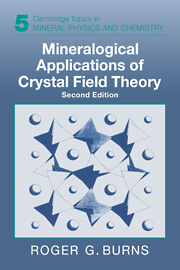Book contents
- Frontmatter
- Contents
- Preface to the first edition
- Preface to the second edition
- 1 Introduction
- 2 Outline of crystal field theory
- 3 Energy level diagrams and crystal field spectra of transition metal ions
- 4 Measurements of absorption spectra of minerals
- 5 Crystal field spectra of transition metal ions in minerals
- 6 Crystal chemistry of transition metal-bearing minerals
- 7 Thermodynamic properties influenced by crystal field energies
- 8 Trace element geochemistry: distribution of transition metals in the Earth's crust
- 9 Mantle geochemistry of the transition elements: optical spectra at elevated temperatures and pressures
- 10 Remote-sensing compositions of planetary surfaces: applications of reflectance spectra
- 11 Covalent bonding of the transition elements
- Appendices
- References
- Subject index
8 - Trace element geochemistry: distribution of transition metals in the Earth's crust
Published online by Cambridge University Press: 23 November 2009
- Frontmatter
- Contents
- Preface to the first edition
- Preface to the second edition
- 1 Introduction
- 2 Outline of crystal field theory
- 3 Energy level diagrams and crystal field spectra of transition metal ions
- 4 Measurements of absorption spectra of minerals
- 5 Crystal field spectra of transition metal ions in minerals
- 6 Crystal chemistry of transition metal-bearing minerals
- 7 Thermodynamic properties influenced by crystal field energies
- 8 Trace element geochemistry: distribution of transition metals in the Earth's crust
- 9 Mantle geochemistry of the transition elements: optical spectra at elevated temperatures and pressures
- 10 Remote-sensing compositions of planetary surfaces: applications of reflectance spectra
- 11 Covalent bonding of the transition elements
- Appendices
- References
- Subject index
Summary
– – although ionic radius and charge are important factors in determining (trace) element distributions, there are other energy factors that need to be considered.
P. Henderson, Inorganic Geochemistry (Pergamon Press, 1982), p. 134Introduction
One outcome of interpreting transition metal geochemistry by crystal field theory is that the theory has enabled some of the basic concepts of geochemistry to be critically evaluated and defined more rigorously. In earlier chapters, crystal field theory was used to explain why some transition elements deviate from periodic crystal chemical and thermodynamic trends shown by other cations with similar charges and ionic radii. In this chapter, criteria for interpreting trace element geochemistry are examined. Examples are highlighted where fractionation patterns applicable to many elements sometimes deviate for transition metal ions. Crystal field effects are shown to be dominant factors influencing the distributions of several of the transition elements in crustal processes during the petrogenesis of igneous, sedimentary and metamorphic rocks.
Trace elements
The classification of chemical elements into major and minor or trace element categories is somewhat arbitrary. Thermodynamically, a minor element may be defined as one that is partitioned between coexisting phases in compliance with laws of dilute solutions, such as Henry's law, eq. (7.2b). In geochemical parlance, however, trace elements are usually categorized on the basis of abundance data. In this context, the mineral, rock or environment containing the chemical elements must be defined as well as the concentration boundary separating a major and trace element.
- Type
- Chapter
- Information
- Mineralogical Applications of Crystal Field Theory , pp. 300 - 352Publisher: Cambridge University PressPrint publication year: 1993



